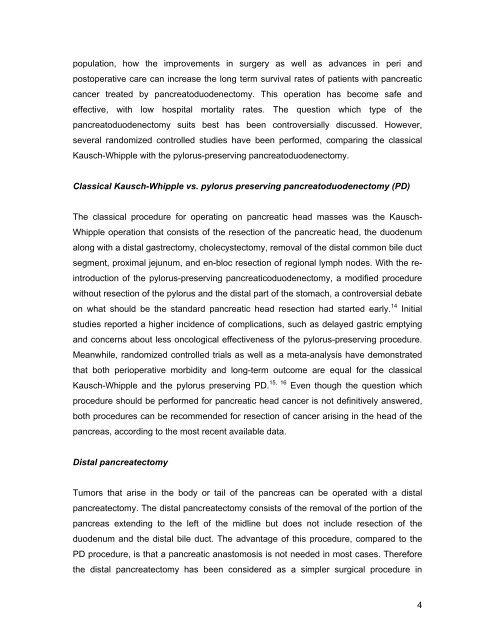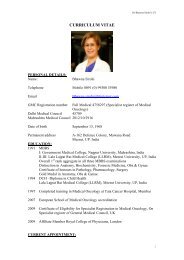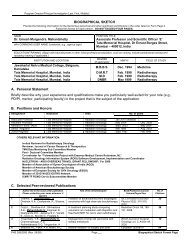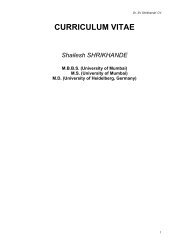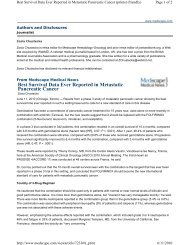Surgical Advances in Pancreatic Cancer- Beat M. Künzli
Surgical Advances in Pancreatic Cancer- Beat M. Künzli
Surgical Advances in Pancreatic Cancer- Beat M. Künzli
You also want an ePaper? Increase the reach of your titles
YUMPU automatically turns print PDFs into web optimized ePapers that Google loves.
population, how the improvements <strong>in</strong> surgery as well as advances <strong>in</strong> peri and<br />
postoperative care can <strong>in</strong>crease the long term survival rates of patients with pancreatic<br />
cancer treated by pancreatoduodenectomy. This operation has become safe and<br />
effective, with low hospital mortality rates. The question which type of the<br />
pancreatoduodenectomy suits best has been controversially discussed. However,<br />
several randomized controlled studies have been performed, compar<strong>in</strong>g the classical<br />
Kausch-Whipple with the pylorus-preserv<strong>in</strong>g pancreatoduodenectomy.<br />
Classical Kausch-Whipple vs. pylorus preserv<strong>in</strong>g pancreatoduodenectomy (PD)<br />
The classical procedure for operat<strong>in</strong>g on pancreatic head masses was the Kausch-<br />
Whipple operation that consists of the resection of the pancreatic head, the duodenum<br />
along with a distal gastrectomy, cholecystectomy, removal of the distal common bile duct<br />
segment, proximal jejunum, and en-bloc resection of regional lymph nodes. With the re<strong>in</strong>troduction<br />
of the pylorus-preserv<strong>in</strong>g pancreaticoduodenectomy, a modified procedure<br />
without resection of the pylorus and the distal part of the stomach, a controversial debate<br />
on what should be the standard pancreatic head resection had started early. 14 Initial<br />
studies reported a higher <strong>in</strong>cidence of complications, such as delayed gastric empty<strong>in</strong>g<br />
and concerns about less oncological effectiveness of the pylorus-preserv<strong>in</strong>g procedure.<br />
Meanwhile, randomized controlled trials as well as a meta-analysis have demonstrated<br />
that both perioperative morbidity and long-term outcome are equal for the classical<br />
Kausch-Whipple and the pylorus preserv<strong>in</strong>g PD. 15, 16 Even though the question which<br />
procedure should be performed for pancreatic head cancer is not def<strong>in</strong>itively answered,<br />
both procedures can be recommended for resection of cancer aris<strong>in</strong>g <strong>in</strong> the head of the<br />
pancreas, accord<strong>in</strong>g to the most recent available data.<br />
Distal pancreatectomy<br />
Tumors that arise <strong>in</strong> the body or tail of the pancreas can be operated with a distal<br />
pancreatectomy. The distal pancreatectomy consists of the removal of the portion of the<br />
pancreas extend<strong>in</strong>g to the left of the midl<strong>in</strong>e but does not <strong>in</strong>clude resection of the<br />
duodenum and the distal bile duct. The advantage of this procedure, compared to the<br />
PD procedure, is that a pancreatic anastomosis is not needed <strong>in</strong> most cases. Therefore<br />
the distal pancreatectomy has been considered as a simpler surgical procedure <strong>in</strong><br />
4


